Are you a productivity enthusiast? Are you looking for the best workflow and project management software for your business? Today, I’m comparing Asana vs. Monday – two top platforms for organizing your workflow.
Monday and Asana are two very different types of software, but both have stand out features that make them a solid choice for practically any kind of online business owner. I’m going to break down their top features, pricing, tell you how customer support stacks up, and go over how user friendly each platform is.
Asana vs. Monday – Which Project Management Software is Best for Your Business?
What is Asana?
Asana is a project management tool that’s great for collaboration because it helps teams track workflows and projects.
It’s not a full scale project management tool because it doesn’t have tools for tracking budgets or expenses, but it still has very strong features that can help many different kinds of business owners stay organized and on task.
Asana gives you templates to organize certain kinds of projects and workflows. They focus on a work graph data model, which includes different ways to visualize your projects from start to finish, such as lists, timelines, calendars, and boards.
Depending on the kind of account you sign up for (more on this shortly), you can use automations, forms, dependencies, and more. These features help teams of people work together and stay synced.
What is Monday?
Monday is less of a project management app and more of a collaboration tool, but that shouldn’t deter you from using it for project management.
That might sound confusing at first, but let me explain: Monday uses a system of very customized and sophisticated spreadsheets where everyone on a team logs their tasks and sees what everyone is working on. It keeps every member of your team focused on their work and working collaboratively.
Monday is like a beautiful version of Google Sheets on steroids.
You can choose from over 200 different templates to start building the kind of spreadsheets that will work for your team, industry, and the kinds of projects you’re working on.
Monday also lets you add different views (Table view is the default, and it’s what looks most like a spreadsheet, but you can also view as calendar, chart, timeline, and Kanban board. Monday also supports a long list of app integrations to offer even more customization and productivity.
Asana vs. Monday – How the two stack up
1. Pricing
Asana pricing
Asana has four different pricing tiers, including a free option that is surprisingly robust if you’re a solopreneur or have a really small team.
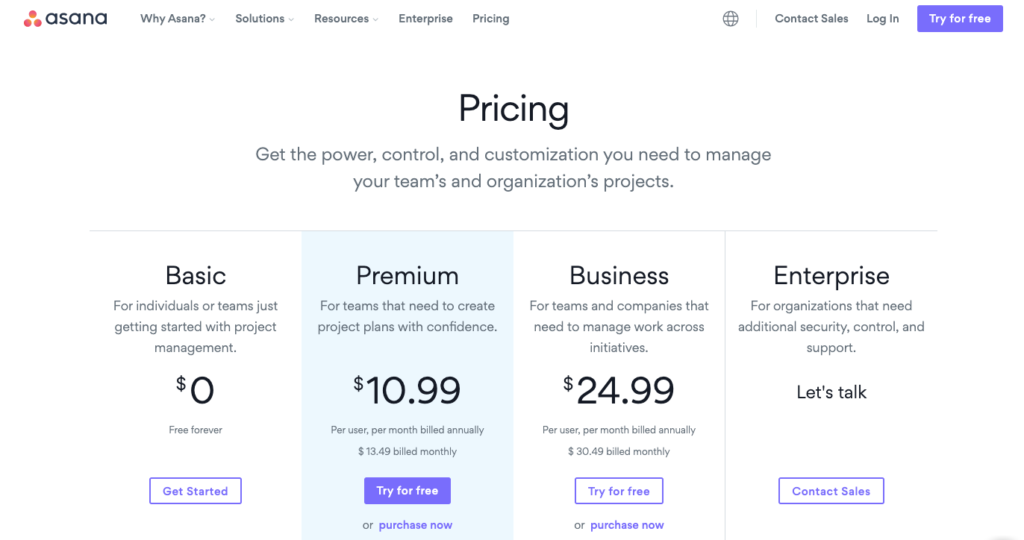
All of Asana’s plans come with unlimited tasks, projects, messages, activity log, and file storage. You can look at projects by list, Kanban board, or calendar view.
You can create project overviews and briefs, and you can also assign tasks and project and set due dates. Asana includes 100+ free integrations with apps like Slack, Salesforce, Gmail, Zapier, Outlook, Zoom, and more.
The free plan accommodates up to 15 users – which is quite a bit more than Monday’s free plan.
Premium ($10.99/month per user when billed annually) gives expanded features like timelines, dashboards, custom fields, forms, rules, milestones, private teams and projects, and an admin console.
Asana Business ($24.99/month per user when billed annually) upgrades further with portfolios, goals, workload, custom rule builder, approvals, proofing, lock custom fields, and it adds advanced integrations for Salesforce, Adobe Creative Cloud, Tableau, and Power BI.
Most small business owners will find all the functionality they need with either Asana Basic or Premium, making it a really affordable solution.
Asana offers a 30-day free trial.
Monday’s pricing
Like Asana, Monday’s pricing is based on how many people will be using the software – they call it “per seat”.

The Individual plan is free, and it’s for up to two users. It comes with up to 1000 items, unlimited boards, over 20 types of columns, 200+ templates, and 500 MB of storage.
Monday’s Basic ($8/month per user) adds unlimited free viewers, Kanban view, embedded forms, 1 board per dashboard, basic activity logs, 5GB storage, and 24/7 support.
Monday says Standard ($10/month per user) is the most popular option. It adds timeline view, calendar view, map view, 250 integrations, 250 automations, 5 boards per dashboard, unlimited activity log, you can share boards, customize forms, create templates, advanced search, integrate email, full API, and 50 GB of storage.
Monday’s Pro Plan ($16/month per user) adds formula columns, time tracking, chart view, 20 boards per dashboard, custom tags, unlimited guests, private boards, Google authentication, and 100 GB of storage. It also comes with 25,000 integrations and automations.
Monday.com offers all users a 14-day free trial.
Results: Overall, Asana offers more options at a lower price point. Plus, you can have up to 15 users on the free plan, well above Monday’s two. For teams larger than 15, Monday’s monthly costs are lower on a per person basis.
2. Features
The features you get with these two apps are where the differences really start to stand out. It’s where you see how Asana is more focused on project management and Monday has a stronger focus on collaboration.
Asana’s features
Asana is focused on project management, so you get tools for task management, communication between your team, workload management, resource sharing, and tracking workflows. Basically, it’s everything you need to complete a project from start to finish.
The task view can be organized in whatever ways makes sense for your project, and Asana has templates to help you get started. Below is a template for a marketing agency collaboration.
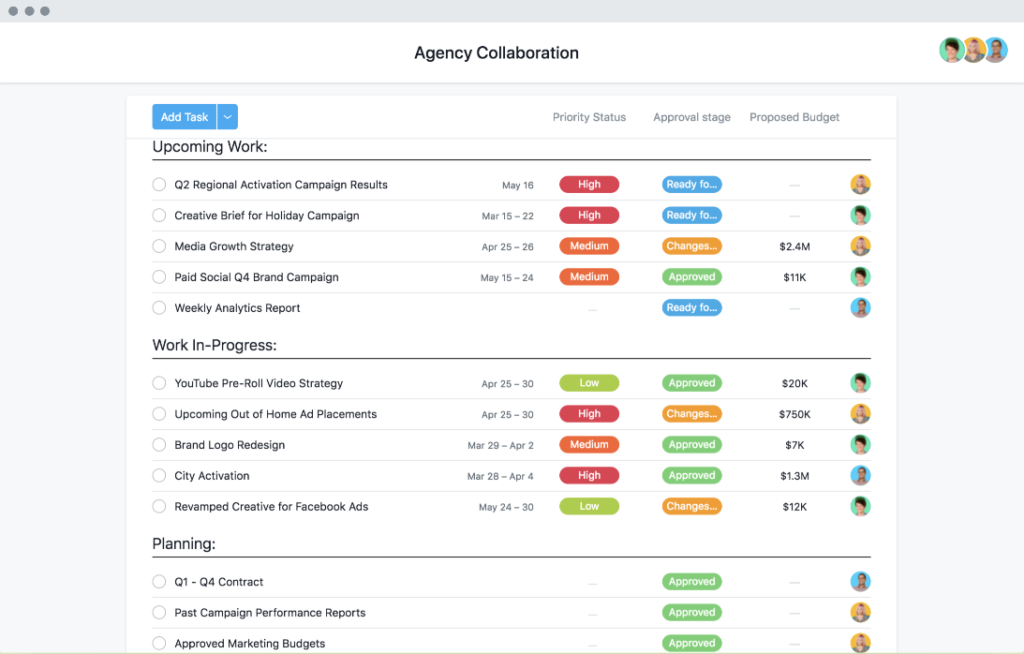
Within any of the tasks you can assign team members to different aspects of each project and set deadlines and dependencies. Within those tasks you can upload files and share links for everyone to access. Users can add comments, upload work, and tag users.
Boards are another way to view projects (both Asana and Monday use Kanban boards).

For any project or task with a date, it will show up in the shared team calendar, and each user can choose which view works best for them for certain kinds of projects and tasks.
Admins can view everyone’s workload to see who’s being over and under utilized, which make sure no one has more on their plate than they can handle.
Monday’s features
In Monday’s board system, each board functions as a macro task or project, and you can have as many boards as you want. You see all of your boards listed on the left hand side of your dashboard, and there’s a nice search function to get where you need to go.
Like Asana, Monday offers lots of templates based on the kind of industry you’re in, project type, etc.
For example, a blogger could use this blog post template. There are columns for category, writer, and a progress bar that tracks what stage each post is at as users complete tasks.
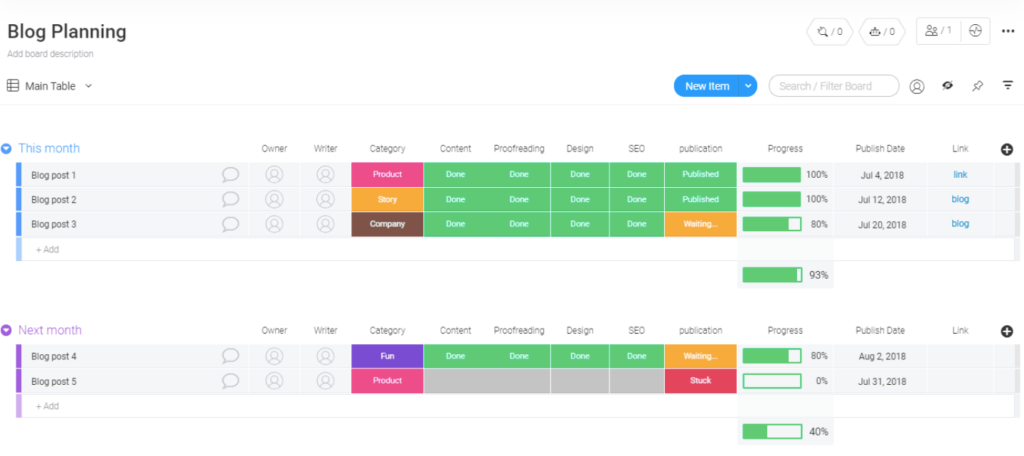
Here’s another very different kind of template for tracking supply orders.
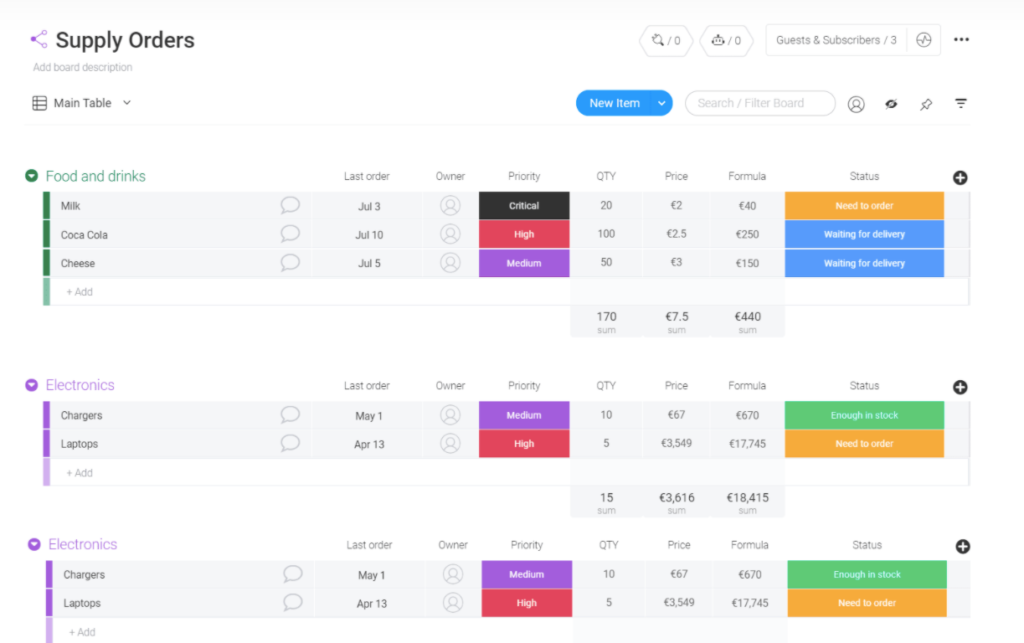
Monday has some really well-designed templates for things like CRM, sales pipelines, competitor analysis, scrum planning, marketing strategies, gap analysis, budget tracking, digital marketing plans, project deliverables, team task trackers, and much more.
Potential customers can even try out some of Monday’s templates before they purchase to see how this software functions.
Results: Monday’s simplicity really stands out when you look at how the templates can work for so many different kinds of businesses. It can be a really functional platform for all kinds of projects, and because you keep each project separated by spreadsheet, there’s almost more organization.
Still it’s hard to beat what Asana offers in terms of larger project management.
3. Support
It’s easy to overlook support when you’re buying software, but poor customer support is a huge bummer to me. And depending on the issue you’re dealing with, bad support can keep you from running your business.
Asana’s customer support
Asana has a series of help guides, webinars, forums, use cases, and articles answering FAQs. Asana also has very detailed step-by-step tutorials to help you get up and running on the platform once you sign up. Overall, these are all really helpful and will typically help with any issue you have.
The downside is that it is very difficult to find an actual contact form to speak with Asana’s support team. I’ve always had a pretty quick response time whenever I’ve had an issue (which is very, very rare), but I’ve read some Asana reviews that say they’ve waited an entire day to work out issues.
Unfortunately there’s no priority level support until you get to Enterprise pricing, which is unlisted and meant for larger organizations.
Monday’s customer support
Monday offers users community forums, video tutorials, webinars, and a knowledge base of help articles. But here’s where they shine: 24/7 customer support via easy-to-find support forms and there’s phone support if you really need it.
Results: It’s hard to compete with phone support, which makes Monday.com stand out for customer support. But I don’t want to overlook that Asana has good tutorials so you can get the most out of the platform.
4. User friendliness
Asana and Monday are both beautifully designed and have very user friendly interfaces, but let’s take a closer look
Asana’s ease of use
When you’re first getting started, Asana can be a little overwhelming. You’ve got a lot of features and options as far as how you can set things up. This is where the tutorials and templates come in really handy.
Asana asks new users a series of questions to help with onboarding, and then they send you guides and use cases to help structure your experience.
Once you’re in Asana and using it, there’s a simple + button to create new tasks and projects. You can easily tag other users, and upload files. There’s a navigation bar on the left side of the page with a message box. And if you use Asana for multiple companies, you can easily toggle back and forth between each of the platforms.
Overall, Asana has a really traditional interface, and it’s pretty hard to get lost once you’ve gotten started.
Monday’s ease of use
Monday has a super simple interface, and they walk you through a quick startup process when you first sign up. You’ll learn the base functions of the software, like how to create tasks or projects.
From there, each project or board you’re working on is listed on the left side of your dashboard. When you need to get to a certain project, you simply click over and see what needs to be done.
I can not overstate the simplicity of Monday, and it may take a second for some users to get use to because it’s not like traditional project management software
Results: Both are winners when it comes to how easy they are to use. Where they differentiate themselves is whether or not you want simplicity (Monday) or function (Asana). This may depend on the way you and your team process work.
Monday vs. Asana – the final word
Both of these platforms have a stellar reputation in terms of how they help people keep track of their work and collaborate with others. And as more and more people work remotely, I expect they will only continue to get better over time.
The biggest difference with Asana vs. Monday comes down to two things: pricing and use.
Asana is generally going to be a less expensive option because you aren’t charged by the user, like Monday. In terms of use, Asana wants to be super functional, and Monday wants to be super simple. Both excel at their goals.
We use Asana here to keep track of our blog post schedule, I use it for my blog Millennial Money Man, and Mike uses it to manage his digital marketing agency. Overall, I’ve had no complaints. Also worth noting, NASA uses Asana… you might say Asana helped land a rover on Mars.
Big companies love Monday too, from Hulu to Adobe. And while I don’t have extensive experience with Monday, what I have used of it is impressive.
The good news is that you can try both Asana and Monday for free to decide which is best for you.
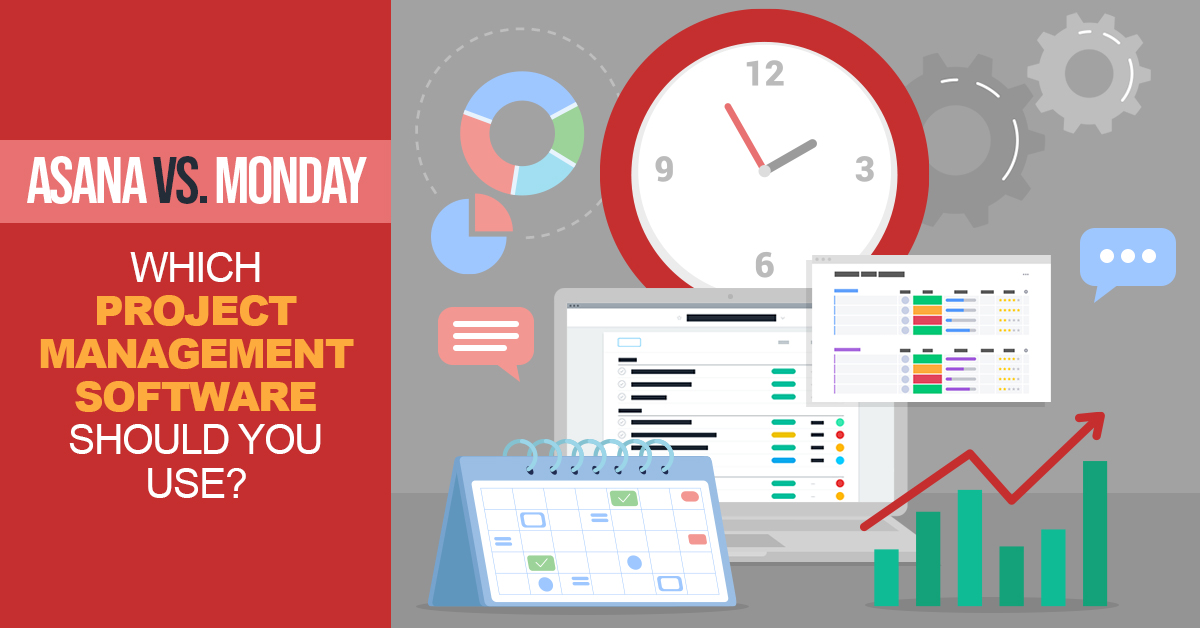

Leave a Reply